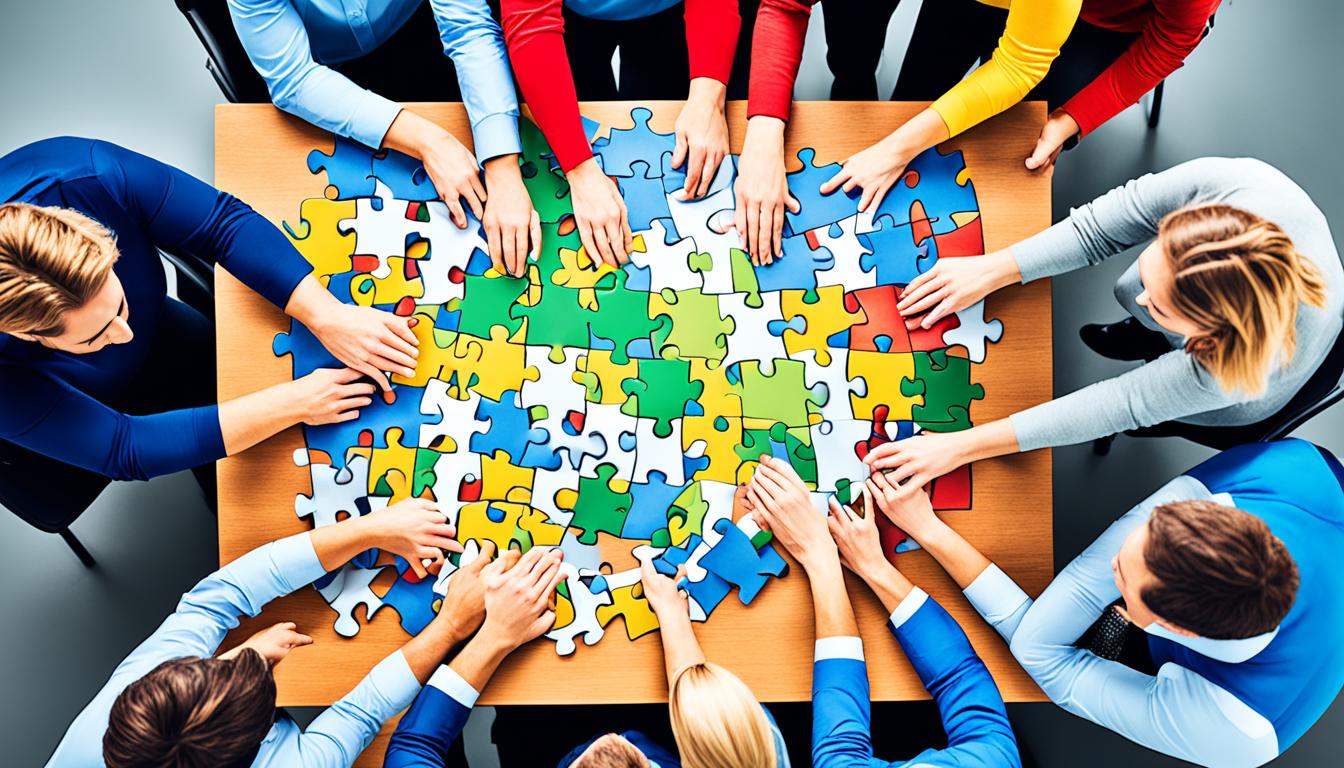Team dynamics training is a valuable investment for any organization looking to improve their team’s effectiveness. The Positive Team Dynamics training program offers effective team building techniques that can enhance team collaboration and foster team cohesion.
This leadership development program provides a comprehensive framework for what a successful team looks like. Whether you are a small team or a large group, this teamwork workshop can cater to your needs, accommodating groups ranging from 1 to 100 people. The program is flexible and can be conducted in-person or virtually, making it convenient for all team members to participate.
During this group dynamics training, participants will learn valuable skills such as improving team communication, building trust, and enhancing collaboration. The program is designed to align the team, establish shared values, and equip team members with the necessary tools to optimize team performance.
Key Takeaways:
- Team dynamics training is an effective way to improve team collaboration and communication.
- The Positive Team Dynamics program offers leadership development and fosters team cohesion.
- The program is flexible and can accommodate groups of various sizes, conducted both in-person and virtually.
- Participants will learn valuable skills such as building trust and enhancing collaboration.
- Investing in team dynamics training can enhance team performance and optimize overall group effectiveness.
The Importance of Team Dynamics
Team dynamics play a crucial role in the success of any team or organization. Positive team dynamics can lead to increased creativity, productivity, and effectiveness. They also foster trust among team members and promote empathy and understanding. Poor team dynamics, on the other hand, can disrupt decision-making, breed distrust, and hinder productivity. It is therefore essential for organizations to understand the meaning and value of team dynamics and strive to optimize them.
By addressing group dynamics, organizations can achieve greater work outcomes, customer satisfaction, and improved bottom line. Positive team dynamics also contribute to workplace diversity, cultural engagement, and employee engagement and well-being.
When team members collaborate effectively and trust one another, they are more likely to share ideas openly, innovate, and take calculated risks. This leads to increased organizational success and a competitive advantage in the market. Furthermore, productive team dynamics foster a culture of continuous learning and improvement, allowing organizations to adapt to changes and stay ahead of the competition.
Research has shown that teams with positive dynamics are more likely to experience high levels of job satisfaction and reduced turnover rates. When team members feel valued, supported, and connected, they are more engaged and motivated to perform at their best. This ultimately enhances team performance and contributes to the overall success of the organization.
Benefits of Team Dynamics:
- Increased creativity and innovation.
- Improved productivity and efficiency.
- Enhanced collaboration and communication.
- Greater trust and cohesion among team members.
- Improved decision-making and problem-solving.
- Higher levels of employee satisfaction and engagement.
- Improved organizational success and bottom line.
Organizations that prioritize team dynamics and invest in strategies to cultivate positive team interactions are more likely to foster a culture of trust, collaboration, and innovation. By creating an environment that encourages open communication, constructive feedback, and mutual support, organizations can empower their teams to reach their full potential.
Quote:
“Teamwork is the ability to work together toward a common vision. The ability to direct individual accomplishments toward organizational objectives. It is the fuel that allows common people to attain uncommon results.” – Andrew Carnegie
By embracing and nurturing team dynamics, organizations can unlock the full potential of their teams, driving innovation, productivity, and organizational success.
| Benefits of Team Dynamics | Description |
|---|---|
| Increased creativity | Positive team dynamics encourage the sharing of diverse ideas and perspectives, leading to more innovative solutions. |
| Improved productivity | When team members collaborate effectively and trust one another, they can achieve higher levels of productivity and efficiency. |
| Enhanced collaboration | Positive team dynamics foster teamwork and effective collaboration, enabling teams to work together smoothly and achieve common goals. |
| Greater trust | Team dynamics based on trust create a supportive environment where team members feel comfortable taking risks and being vulnerable. |
| Improved decision-making | When team members trust and respect each other, they can make better decisions collectively, drawing on diverse perspectives. |
| Higher employee satisfaction | Positive team dynamics contribute to a positive work environment, leading to higher levels of job satisfaction and employee engagement. |
| Improved organizational success | By optimizing team dynamics, organizations can achieve better outcomes, higher customer satisfaction, and overall organizational success. |
Creating and maintaining positive team dynamics require effort and continuous attention. It involves fostering open communication, providing opportunities for team members to develop their skills, and promoting a culture of trust and collaboration. By prioritizing team dynamics, organizations can unlock the full potential of their teams and drive innovation, productivity, and organizational success.
Factors Affecting Team Dynamics
Several factors contribute to effective team dynamics, which play a vital role in the success of any team or organization. By understanding and optimizing these factors, teams can enhance their collaboration, communication, and overall performance. The key factors influencing team dynamics include:
- Team Culture: A positive team culture that promotes psychological safety and a sense of belonging creates an environment conducive to effective team dynamics.
- Leadership: Strong leadership is crucial for motivating, supporting, and guiding team members toward achieving their shared goals.
- Shared Goals: Having clearly defined and shared goals provides direction and purpose for the team, fostering alignment and commitment.
- Trust: Trust is essential for building collaboration and open communication among team members, fostering a supportive and cohesive team environment.
- Decision-Making Skills: Effective decision-making skills ensure that the team can make informed and timely decisions, enhancing productivity and problem-solving abilities.
- Teamwork or Collaboration Skills: Strong teamwork skills enable effective cooperation, coordination, and synergy among team members.
- Communication Skills: Clear and open communication is crucial for sharing information, ideas, and feedback, facilitating understanding and minimizing misunderstandings.
- Conflict Resolution Skills: The ability to address conflicts and resolve them constructively enables the team to maintain healthy relationships and overcome obstacles.
- Team Alignment: Ensuring that everyone in the team is working towards a common objective and is aware of their roles and responsibilities enhances coordination and minimizes conflicts.
By considering and nurturing these factors, teams can create a strong foundation for effective team dynamics and unlock their full potential for success.

Common Causes of Poor Team Dynamics
Poor team dynamics can have detrimental effects on the overall functioning and success of a team. Understanding the causes behind these poor dynamics is essential for organizations to address and rectify the issues. Some of the common causes of poor team dynamics include:
- Poor Communication: Inadequate or ineffective communication within a team can lead to misunderstandings, lack of clarity, and misalignment. When team members are unable to effectively express their ideas, share information, or collaborate, it can create a negative atmosphere that hampers productivity and teamwork.
- Poor Project Management: Lack of proper project management skills and practices can result in inefficiency, missed deadlines, and confusion. Without clear goals, roles, and responsibilities, team members may feel overwhelmed, frustrated, or directionless, ultimately impacting team dynamics.
- Lack of Trust: Trust is the foundation of any successful team. When trust is lacking among team members, it can hinder collaboration, open communication, and the willingness to take risks. Without trust, team members may hesitate to share ideas, provide feedback, or seek support, leading to poor team dynamics.
- Conflicts: Unresolved or poorly managed conflicts can have a significant impact on team dynamics. When conflicts arise due to differences in opinions, values, or approaches, they can create tension, division, and mistrust within the team. It is crucial to address conflicts promptly and facilitate constructive resolution to maintain positive team dynamics.
- Ineffective Leadership: Leadership plays a crucial role in shaping team dynamics. Ineffective leadership that lacks proper guidance, support, and direction can create confusion, demotivation, and a lack of cohesion within the team. When team members feel unsupported or undervalued, it can harm team dynamics and overall performance.
In order to foster positive team dynamics, organizations must address these causes and implement strategies to mitigate their impact. By promoting effective communication, providing strong project management support, building trust, resolving conflicts, and cultivating effective leadership, organizations can create a conducive and productive team environment.
“Poor team dynamics can be detrimental to both the team’s performance and the well-being of its members. It is crucial for organizations to identify and address the root causes of poor team dynamics in order to foster a positive and high-performing team culture.”
Addressing poor team dynamics allows organizations to improve team collaboration, enhance productivity, and drive successful outcomes. By addressing the causes of poor team dynamics, organizations can create a positive and conducive environment that supports team cohesion, open communication, and trust.

| Causes of Poor Team Dynamics | Impact on Team |
|---|---|
| Poor Communication | Misalignment, misunderstandings, lack of clarity |
| Poor Project Management | Inefficiency, missed deadlines, confusion |
| Lack of Trust | Lack of collaboration, closed communication, risk aversion |
| Conflicts | Tension, division, hindered collaboration |
| Ineffective Leadership | Confusion, demotivation, lack of cohesion |
Strategies to Improve Team Dynamics
Improving team dynamics requires a proactive approach. Organizations can implement several strategies to enhance team dynamics and create a more cohesive and productive work environment.
Diagnosis of Team Dynamics
A crucial first step is to conduct a thorough diagnosis of the team dynamics through a team health check. This involves observing the team at work, conducting individual interviews, and gathering feedback from relevant stakeholders. The aim is to identify the specific causes behind poor team dynamics, such as weak leadership, authority and groupthink, blocking behaviors, and free riding.
Defining Team Roles and Accountabilities
Clear and well-defined team roles and accountabilities are essential for effective team dynamics. By establishing individual responsibilities and clarifying expectations, team members can work together more efficiently and avoid confusion or conflicts. This promotes collaboration and ensures everyone understands their contribution to the team’s success.
Strong Leadership
Strong leadership plays a crucial role in improving team dynamics. A competent and supportive leader can provide guidance, motivation, and support to team members. They can foster a positive team culture, establish trust, and promote open communication. Additionally, strong leadership helps resolve conflicts quickly and ensures the team stays aligned with its goals and objectives.
Conflict Resolution
Conflict is inevitable within a team, but how it is managed can significantly impact team dynamics. Organizations should encourage and provide training for conflict resolution skills to team members. By addressing conflicts in a timely and constructive manner, teams can overcome differences, find common ground, and maintain a harmonious working relationship.
Building an Inclusive Team Culture
A positive team culture promotes trust, psychological safety, and open communication. Organizations should foster an inclusive environment where diverse perspectives are valued and respected. A culture that encourages collaboration, innovation, and continuous learning enhances team dynamics and leads to better problem-solving and decision-making.
Encouraging Open Communication Channels
Open communication is a vital component of effective team dynamics. Organizations should establish and encourage open channels where team members can freely express their ideas, concerns, and feedback. This enables clearer and more transparent communication, promotes understanding, and helps build trust among team members.
Implementing these strategies can have a significant impact on team dynamics and ultimately improve team effectiveness. By addressing the root causes of poor team dynamics and fostering a positive and supportive work environment, organizations can unlock the full potential of their teams and achieve greater success.
Conclusion
Team dynamics training is a valuable tool for organizations looking to improve team effectiveness and optimize team performance. By investing in team dynamics training, organizations can enhance collaboration, communication, trust, and decision-making within their teams. This leads to increased productivity, innovation, and employee engagement.
By addressing the factors that contribute to poor team dynamics and implementing strategies to improve them, organizations can create a positive and high-performing team culture. Team dynamics training helps teams understand the importance of effective communication, active listening, and conflict resolution, which are essential for smooth team dynamics. It also empowers team members with the skills and knowledge needed to work together more efficiently and optimally.
Ultimately, investing in team dynamics training not only benefits the organization but also contributes to the overall well-being and success of its employees. By improving team dynamics, organizations foster a supportive and collaborative environment that leads to higher job satisfaction, better employee retention, and greater organizational success. The benefits of team dynamics training are evident in improved team effectiveness, optimized team performance, and a positive work atmosphere.
FAQ
What is team dynamics training?
Team dynamics training is a program designed to improve the effectiveness of a team by addressing various aspects of team dynamics such as collaboration, communication, trust, and decision-making skills.
How does team dynamics training enhance team collaboration?
Team dynamics training helps team members develop better communication skills, build trust among each other, and understand how to work together more effectively, leading to improved collaboration.
What is the Positive Team Dynamics training program?
The Positive Team Dynamics training program is a recommended option for organizations looking to improve their team’s effectiveness. It focuses on aligning as a group, building trust, establishing team values, and enhancing collaboration skills.
How much does the Positive Team Dynamics training program cost?
The cost of the Positive Team Dynamics training program starts at ,795 for in-person training and ,850 for virtual training.
Who can participate in the Positive Team Dynamics training program?
The Positive Team Dynamics training program is available for groups of any size, ranging from 1 to 100 people. It can be conducted in-person or virtually.
What are the benefits of team dynamics?
Positive team dynamics can lead to increased creativity, productivity, and effectiveness. They also foster trust among team members and promote empathy and understanding.
What factors affect team dynamics?
Team dynamics can be influenced by factors such as team culture, leadership, shared goals, trust, decision-making skills, teamwork or collaboration skills, communication skills, conflict resolution skills, and team alignment.
What are the common causes of poor team dynamics?
Poor team dynamics can arise due to factors such as poor communication, poor project management, lack of trust among team members, conflicts, and ineffective leadership.
How can team dynamics be improved?
Strategies to improve team dynamics include conducting a team health check to diagnose the specific causes of poor team dynamics, defining team roles and accountabilities, establishing strong leadership, resolving conflicts quickly, building an inclusive team culture, and encouraging open communication channels.
Why is team dynamics training important?
Team dynamics training is important because it enhances team collaboration, communication, trust, and decision-making skills, leading to increased productivity, innovation, and employee engagement.
How can team dynamics training improve team effectiveness?
By addressing the factors that contribute to poor team dynamics and implementing strategies to improve them, team dynamics training helps create a positive and high-performing team culture, leading to improved team effectiveness and performance.


